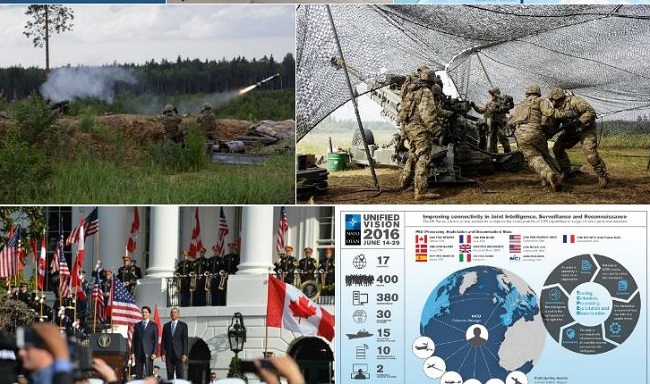Prime Minister Justin Trudeau today announced the deployment of Canadian troops, fighter jets and military equipment in Eastern Europe as the North Atlantic Treaty Organization (NATO) step up efforts to deter Russia aggression in the region.
In what the government calls its “largest sustained military presence” in Europe for more than a decade, Canada will lead a multinational NATO battle group in Latvia as part of the military alliance’s enhanced forward presence in Eastern Europe.
This military contribution is being described as a “framework battalion” which means Canada is providing the backbone of the 4,000-strong force made up of Canadian, American, British and German troops.
.@CanadianPM Justin Trudeau arrives in Poland for #NATOSummit pic.twitter.com/8QaVCZtoii
— Canada at NATO (@CanadaNATO) July 8, 2016
The Royal Canadian Navy will also deploy a frigate that will conduct operational tasks with NATO’s maritime forces in the region. Up to six CF-18 fighter jets from the Royal Canadian Air Force will carry out periodic surveillance and air policing activities in Eastern Europe.
“Canada is a playing a strong and constructive role in the world,” Trudeau said at his very first NATO Leaders’ Summit in Poland. “We are ready to respond to support NATO with some of the most effective soldiers, sailors, and airmen and airwomen in the world.”
Proud to sign #EU – #NATO declaration with @eucopresident and @JunckerEU. Together we are stronger. pic.twitter.com/2CgvopZN5X
— Jens Stoltenberg (@jensstoltenberg) July 8, 2016
Since Russia’s annexation of Crimea in 2014, NATO has moved to expand it multinational reaction force in the Baltic to 40,000 troops that can be deployed within a week. The new ultra-mobile brigade of 4,000 soldiers can be deployed to trouble spots within two days.
Russia is not standing still.
In May this year, Russian Defence Minister Sergei Shoigu announced plans to create two new army division made up of 20,000 soldiers that will be stationed along the country’s western and southern borders, according to the defence publication Janes.
“The Defence Ministry is undertaking steps to counter the growing NATO potential in close proximity to Russian borders,” Shoigu said in a statement.
Last month, NATO Secretary General Jens Stoltenberg made a personal pitch for Canada take part in building the force.
NATO is deploying the battle group around Latvia’s border with Russia to serve as a buffer against what has been seen as a resurgence of Russian aggression in the region. The deployment is also meant to reassure some of NATO’s newest members such as Estonia Lituania, and Latvia who have become worried over Russia’s annexation of Crimea in 2014 and its involvement in the ongoing war in Ukraine.
UK forces are at the heart of @NATO‘s defence. Watch to find out more about our #Warsaw #NATOSummit 2016 prioritieshttps://t.co/zQPtXnELZt
— Foreign Office (FCO) (@foreignoffice) July 8, 2016
Not everyone approves of NATO’s recent moves.
In June, German Foreign Minister Frank-Walter Steinmeier characterized NATO’s actions as “warmongering” after the alliance conducted military exercises in Eastern Europe.
He said the move was counterproductive to regional peace and warned that it could increase tensions with Russia, a report from the BBC said.
However, at the opening of the NATO Leadership Summit in Poland yesterday, the alliance said that the Euro-Atlantic community is “facing unprecedented challenges emanating from the South and East” and that is citizens demand NATO “use all ways and means available” to address the threat.
“In light of the common challenges we are now confronting, we have to step-up our efforts: we need new ways of working together and a new level of ambition; because our security is interconnected; because together we can mobilize a broad range of tools to respond to the challenges we face; and because we have to make the most efficient use of resources,” the joint statement by Stoltenberg, Donald Tusk, president of the European Council, and Jean-Claude Juncker, president of the European Commission said.
The statement also outlined several NATO objectives:
- Boost NATO’s ability to counter hybrid threats, including by bolstering resilience, working together on analysis, prevention, and early detection, through timely information sharing and, to the extent possible, intelligence sharing between staffs; and cooperating on strategic communication and response.
- Broaden and adapt NATO operational cooperation including at sea, and on migration, through increased sharing of maritime situational awareness as well as better coordination and mutual reinforcement of our activities in the Mediterranean and elsewhere.
- Expand NATO coordination on cybersecurity and defence including in the context of our missions and operations, exercises and on education and training.
- Develop coherent, complementary and interoperable defence capabilities of EU Member States and NATO Allies, as well as multilateral projects.
- Facilitate a stronger defence industry and greater defence research and industrial cooperation within Europe and across the Atlantic.

